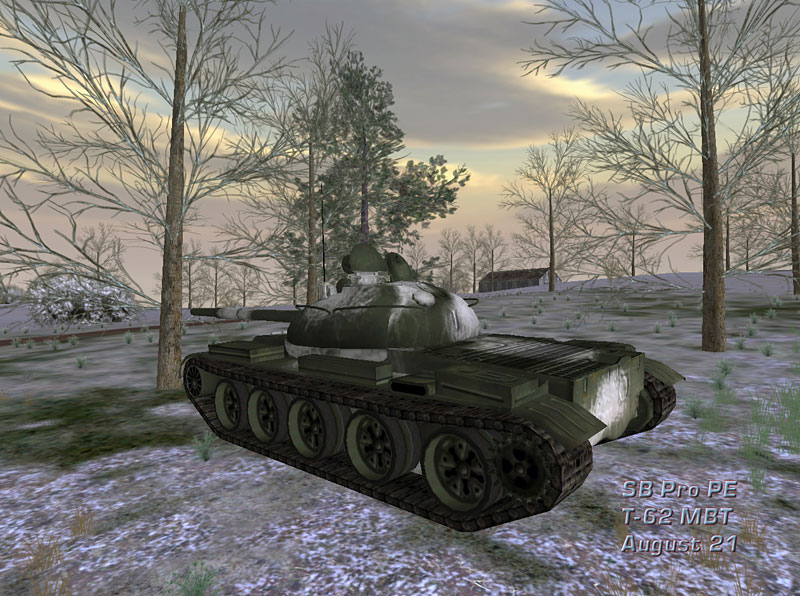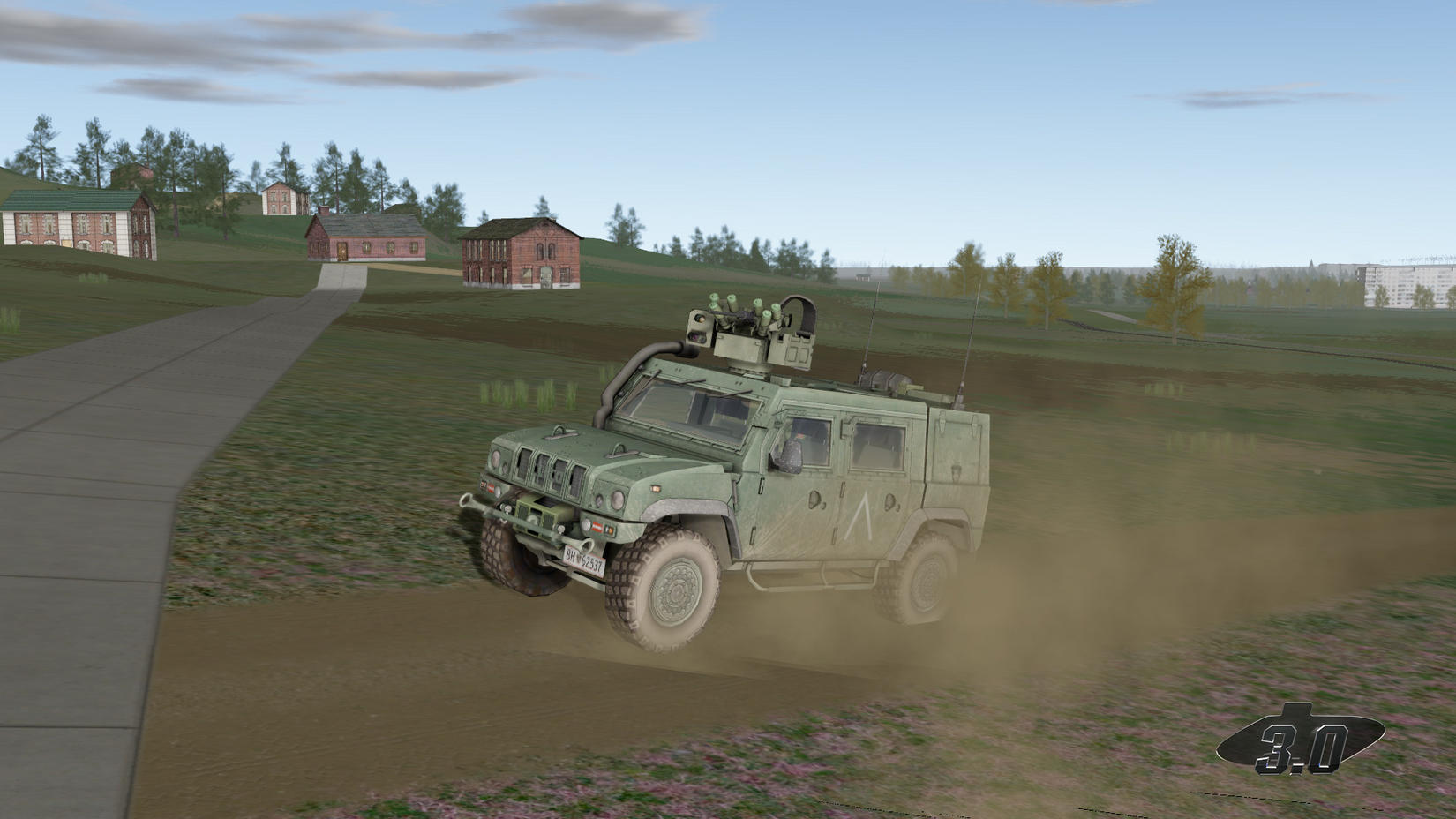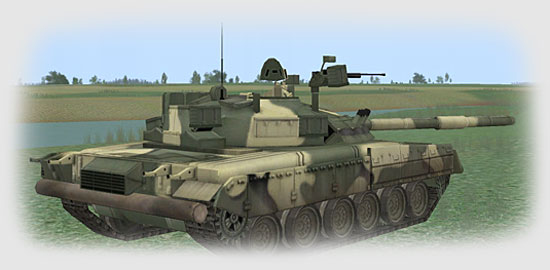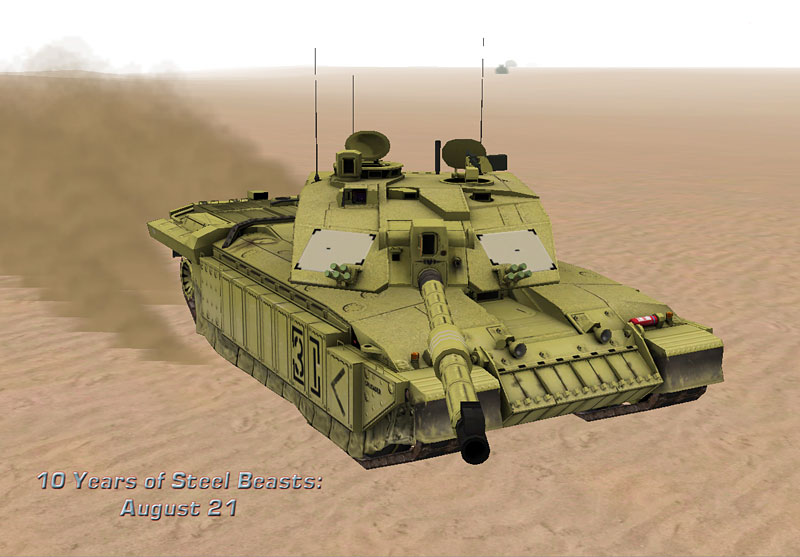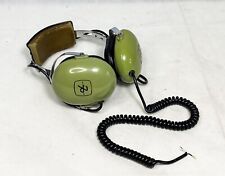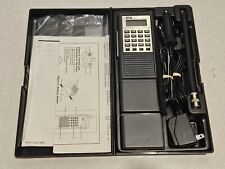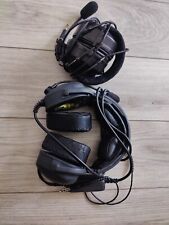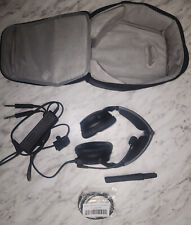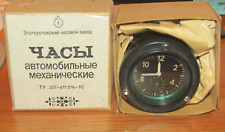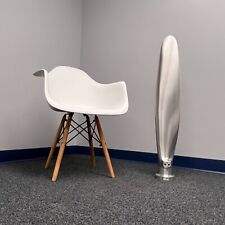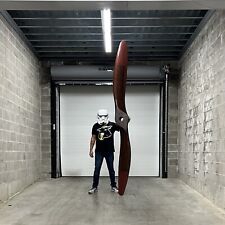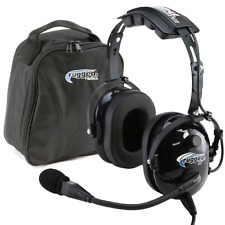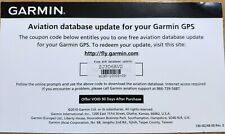
Steel Beasts Resources
| Steel Beasts Web Sites | |
| www.steelbeasts.com | |
| www.esimgames.com | |
| www.tanksim.com | |
| Wikipedia Steel Beasts |
| Steel Beasts Screenshots | |
| Steel Beasts’ History (opens a new window) |
|
| SimHQ Exclusive Previews: Steel Beasts Pro PE version 2.538 |
|
 |
British Challenger |
 |
T-55 MBT |
 |
T-62 MBT |
 |
M60A3 TTS |
| Steel Beasts 2.5x Preview Video | |
Introduction
 Ten years ago today, eSim Games released arguably the greatest armor simulations ever produced — Steel Beasts.
Ten years ago today, eSim Games released arguably the greatest armor simulations ever produced — Steel Beasts.
While Steel Beasts was released on August 21, 2000, it actually started life years before. The excerpt below is from John “Spoons” Sponauer’s interview with Nils “Ssnake” Hinrichsen published on SimHQ way back on August 15, 2000.

With the release of Steel Beasts coming soon, we asked some of the people involved in the game’s development to talk about how it was developed, with what philosophy, and with what goal in mind. Today, we asked “Ssnake” a German Army Tank Officer who served as the game’s Technical Director, about how Steel Beasts came to be.
Here’s what Nils wrote.
 “It all began with the mother of all serious tank simulations — M1 Tank Platoon, 1989.
“It all began with the mother of all serious tank simulations — M1 Tank Platoon, 1989.
The Amiga version that I had provided cool sounds, good gameplay, and — for that time — reasonable graphics. In fact, the graphics were so extremely simple that it actually helped to make educated decisions about where to find a hull-down position.
I was in the German Bundeswehr back then already, and (due to other reasons) in 1990 I joined the Panzertruppe. I became a tank officer. Riding Leopard tanks was great. I continued to play M1 Tank Platoon, and I started to wonder how much time it would be until finally a Leopard sim would come out for me to play it as well. Never could I even dream of becoming part of a developer team to do just that one day.
Well, for a while I was busy with driving tanks and other army duties, so I hardly realized how quickly time passed while nothing happened on the tank sim market. In 1993 I learned about the Internet, and in 1997 iMagic published iM1A2.
In retrospect, iM1A2 was horrible in some areas, and pretty cool in others. It took me some time to realize that there was no ballistic model at all. I was trained in the army not to waste my ammo, so I always lased and aimed at center mass (well, actually I didn’t in the beginning due to some different gunnery routines of the Leopard, but little I knew about the numerous differences between M1 and Leo back then…!). All of my rounds hit, and since I had been a pretty good gunner in all the years, I didn’t expect to fail. Then I started to experiment, and when I noticed that I could aim just anywhere near the target and would still score a hit, the disappointment was bottomless.
The looks were in the tradition of M1TP (simplistic, even horrible), but iMagic pioneered vast open polygon based terrain, so we shouldn’t be too harsh with them. The strategic AI was cool, though. It even managed to fool me, sometimes; for instance, when I was supposed to defend an area, I didn’t automatically lose because the enemy managed to sneak in…I was allowed to recapture it, and that was all I needed to be satisfied back then.
iMagic offered a discussion forum. That’s standard today, but it was a new experience to me that a company offered a place where you could discuss -and criticize- their product; sometimes developers were present, and answered your questions. This direct contact impressed me a lot… it was a first-timer for me. I posted some messages, commenting on other customer requests, and represented the German point of view to some topics discussed there. It was a nice experience to meet tank crews from other parts of the world, and I don’t mean just the US.
 Somehow my postings must have struck a guy in Silicon Valley named Al Delaney. He had invented a new terrain rendering algorithm during his studies which was looking better than anything else on the PC market back then. It was a lightning fast engine. It looked so good that his friends talked him into turning this into a game. He pondered whether to make a golf sim or a tank sim. There were many golf games available in ’96, but hardly any tank sims, so he decided to go left. He also bought a copy of iM1A2 as a part of the market analysis, and he studied the postings on the discussion board to find out more about what people wanted to have in a tank sim.
Somehow my postings must have struck a guy in Silicon Valley named Al Delaney. He had invented a new terrain rendering algorithm during his studies which was looking better than anything else on the PC market back then. It was a lightning fast engine. It looked so good that his friends talked him into turning this into a game. He pondered whether to make a golf sim or a tank sim. There were many golf games available in ’96, but hardly any tank sims, so he decided to go left. He also bought a copy of iM1A2 as a part of the market analysis, and he studied the postings on the discussion board to find out more about what people wanted to have in a tank sim.
He then wrote me an email.
I was careful. I didn’t know anything about him. He could have been a Russian spy, or a totally inept hobby programmer trying to do a cheesy shareware product. I agreed to answer his questions as long as they didn’t cover classified subjects (not that I knew anything about classified things).
He sent a few screen shots.
I fell out of my chair.
I yelled for my buddies, and showed them the terrain.
We were hooting like mad.
That instant, I knew I had to do everything I could to prevent this project from going down, or wasting all the potential to good looks and a bad simulation part. I decided to join in. Little I knew about the amount of work that would be involved by this — but despite all the work I put into this sim, I don’t regret and wouldn’t want to miss a single minute of it.
I fell in love with “The tank sim without a name”
© 1997 by Alexander H. Delaney.
Al wanted to make a tank game featuring the M1, the Leopard 2, and the T-80, and he asked if I could help him to get the Leo right. We expected to finish development by Summer of 1997. He originally had a simple platoon-scale game in mind, but slowly I began to talk him into something bigger.
He was hesitant, but I guess my arguments must have been tempting and persuasive. There isn’t much you can do with a single platoon on the battlefield. Even a company, despite being a complicated thing to lead in real life, is not a really new experience in terms of tactical versatility. It sure is more than just a bunch of platoons, but a pure company lacks a lot of combat support elements which (in at least in the German Bundeswehr) are located at battalion staff HQ. From the point of gameplay, the sim should cover the full range of combined arms warfare.
We discussed the general market situation. All of a sudden a tidal wave of tank games flooded the market. Novalogic’s “Armored Fist” and “Armored Fist 2,” Microprose’s “M1 Tank Platoon 2,” “Wargasm,” “Spearhead”… this was bad. We knew we couldn’t compete with development teams of 15 or even more than 30 guys… we had no budget to spend on eye candy, in fact we hardly had a budget at all. We had no real expertise in computer graphics. There was no way we could create a big Hollywood style production. Furthermore, Al is an engineer, and so am I. I wanted an accurate sim with as little abstractions as possible, and it seemed that this was his intent as well, so we decided to target a small niche. We wanted to make the most accurate tank sim of at least the M1A1 and Leopard 2A4 for the PC platform. This was where our competence was, this was where we could beat all other competitors. But would we be able to beat Microprose as well ?
Time would tell, and luckily even the biggest threat, M1TP2, turned out to be a “sim lite” by our standards. It sure was a fine game, but sure as hell it could have been a great game if only the game designers had cared a bit more about the little details. We considered that there still was a market for us, and continued development, which was an easy choice for me, but not for Al Delaney. I had a regular income, and he did not.
The first playable version I received around January of 1997 fired big red tomatoes. It featured bitmapped tanks 128 images per vehicle (there was but one), all in desert yellow cammo paint. The ground textures were rather primitive. The landscape was empty. There was no dedicated enemy; you could kill friendlies only. You could lase, fire, and drive around. Then we got some enemies in fixed positions. They didn’t shoot back, but smoked well when killed. Then came the trees. One tree per tile. Then a lot of them. We found out that it seemingly made no performance difference whether a thousand, four thousand, or ten thousand trees were to be seen. The game ran fine on a P90 and a target machine was a P133.
Red tanks, flying tomatoes, and a catchy name.
By now I was screaming for a scenario editor. One day Al came up with it. Previously, I had fantasized in great length about what I had in mind, and what I got was a fantasy come true (let me tell you: It’s really cool to have a personal programmer!). Just a few little features more, and it would allow me to build some nice missions.
It was spring ’98 by now. I tested how much the engine could handle, and built a crazy mission that I was sure would make the game crash. More than 550 vehicles were put into that mission — one battalion of blue defenders versus one and a half red tank regiments! The first time I saw the avalanche of Red’s attack, I was downright frightened. There were so many targets, I hardly knew where to start — and these guys were shooting back! Furious action arose… bullets flying everywhere, and exploding tanks wherever I looked. It was a nightmare. For the first time of my life I had gotten a faint glimpse of what the chaos of a real battlefield could be like. All the training of the Bundeswehr couldn’t have prepared me for this experience.
This was the moment when I knew we had created a real simulation. We defined the rules, but the computer would do the number crunching to present the surprising outcome. I, the maker of the scenario, was totally surprised by the results.
And the game did not crash. It ran just fine… stable and smooth.
In the summer of 1998 I visited Al Delaney in Silicon Valley. To the dismay of his wife and my girlfriend, we didn’t do a vacation…we spent a considerable amount of time discussing some aspects of the computer control logic (“artificial intelligence”). These 14 days were extremely productive (and showed the limitations of email exchange, even if it as heavy as between the two of us), and resulted in a dramatic improvement in the computer controlled units, especially their reaction to enemy fire. From now on they would back up, and find a new position more or less close to the old one. Movement tactics were refined.
We agreed with our better halves that by Christmas of 1998 all development would stop, and the game had to be sold then.
Steel Beasts 1998… still red tanks, but more features added,
and getting closer to an actual sim.
It was downright funny sometimes; I came up with a test purely rooted in tanking practice. Al would never have dreamed about some of my primitive approaches, but with a two minute test and compiler run we achieved the same progress as in a three week period before. Maybe I SHOULD move to the states, but maybe that would result in immediate divorce for both of us. Nah…
Of course, the addition of more and more code increased the CPU workload. But progress was obvious, and the game became significantly better every month. We decided to invest in some artwork.
Curtis Ratica came up with nice polygon models of eight tanks, and some close-up views of the turret roofs of M1 and Leopard 2. He made cool explosions, and some nice artwork for the menus which was lost soon thereafter because we had to change the menu structure. We got high explosive, smoke, and ICM artillery barrages. Tanks began to throw up dust according to their speed. It was winter of 1998 by now, and it was clear that if the game was released in this state, it’d be a big mistake. It showed a lot of potential, but it was by no means a finished product. We talked our wives into another six months; July 4 would be their Independence Day as well.
We learned that ICM and smoke arty were real performance killers. I mean, it was really bad. My reference mission — the regimental assault — dropped to an all-time low of just two frames per second when being in heavy artillery barrage. Time to buy a new computer! Overclocking the P150 to 180 MHz had reached its limits. Luckily the new cache equipped Celeron was fairly cheap, and 333MHz began working for Steel Beasts.
Looking back to 1999, it appears at first sight to be an almost blank year, which does it no justice. A lot of time was seemingly wasted in the hunt for a publisher. Nobody was willing to invest the comparatively tiny sum that was necessary to convert the game into a 3D accelerator supporting polygon engine. Al prepared the existing code for a swift engine migration which never came. This rendered all existing scenarios useless.
Bye, bye, “big_delay.sce” Farewell, “scouting.sce,”
you wickedest of all my scenarios!
More and more testers were introduced into the beta team. We got active duty M1 tankers, guys from Sweden, retired US tankers, and we started to discuss numerous aspects of the gameplay. We formed (and still are) probably the most competent and detail oriented beta test group a tank sim development team the world has seen so far. Finally, we had offers from three small publishers, and decided that Shrapnel was the partner of our choice. This was a huge relief, but it also forced us to increase development speed.
 In November of 1999, Ed “Volcano Man” Williams dropped by. He is an active duty tanker of the US armored forces, and on top of that, he knows his business as a sound engineer. He had already produced a third-party sound pack for Panzer Elite.
In November of 1999, Ed “Volcano Man” Williams dropped by. He is an active duty tanker of the US armored forces, and on top of that, he knows his business as a sound engineer. He had already produced a third-party sound pack for Panzer Elite.
His work, once again, totally changed the way Steel Beasts still impresses me today.
Volcano’s work sets new standards for the whole genre of tank simulations. This must be seen under the light that I couldn’t provide him with many original Leopard sound recordings. All right, I took about 20 minutes of audio footage with a DAT recorder in the field so that he had a good basis for engine noise and other peacetime sounds, but what about artillery, machine gun fire, or autocannons that none of us had on tape? All we could do is tell him “Yeah, increase the rate of fire a bit, please, and more oomph — no, not so much, it’s more like, uh, well I dunno… couldn’t you just make a few variations, and we tell you what sounds better?”
And he did.
Creating sounds is an art that’s totally underrated — I didn’t consider it important myself. I freely admit that, because I changed my mind. Steel Beasts had in no way sounded like the huge, wild cats it depicts. It was a downright cheesy sound. Today, listening to the sound will impress the casual gamer, and astound the expert. You can actually hear what autocannon fired two seconds ago (if it is 700 meters away), because sound actually travels at the speed of sound in Steel Beasts, and actually has since the introduction of gun fire booms and muzzle flashes in 1997).
In spring of 2000, one more important thing was left in the pipeline; multiplayer. I always considered “Steel Beasts” to be a training tool suitable for tactical education of your officer cadets, NCOs, and other guys similar to me when I played “M1 Tank Platoon” in the barracks, ten years ago. My idea was to let the platoon leader or company leader create a scenario, and let his subordinate leaders develop a solution. Then play their plans, and watch the results. You can easily find out what will work, and what won’t, under the given conditions.
The real time multiplayer feature adds a new dimension. Steel Beasts allows two players to form a crew of gunner and tank commander. It allows you to form a platoon of six or eight human players. I’m not sure about the network capability in a LAN environment, but at least we know that all it takes in Internet play is a cable modem host for a group of eight. We will continue working in this area. I probably shall be surprised by the potential of Steel Beasts once again.
So, what about the future?
We do have plans, but I would rather not reveal them at this point of time. First, there might be a competitor reading this (not that I know of any). Second, no plan survives contact with the enemy. There are a lot of variables which remain uncertain these days — but if you all continue to support us, and if you all continue to observe our actions, there’s no doubt that you will notice in time. Be assured, we will continue to your input. Customers usually are the best inventors a company can get.”
 |
Steel Beasts is more of a training simulation for various militaries around the free world than an actual computer game. Sure it was released and sold as such, but the heart of the product has always been a training tool. A simulation of main battle tanks in a modern setting with modern equipment and tactics.
I personally remember buying the Steel Beasts Gold Edition from my local computer store (way back when they actually sold computer software). I also remember loving the game/sim but finding it very difficult, so never really exploring it more than the excellent tutorials and quick easy missions.
In March 2006 it was time for eSim Games to release the follow-up, Steel Beasts Professional Personal Edition. The professional version was already being used and updated in different militaries; the personal edition was released for tankers to train at home and on their own time, kind of like homework. Lucky for us civilians who only dream of being a tanker, it was released to the gaming public via the eSim Games web site.
Throughout its release Steel Beasts Pro PE has been patched and updated, with tons of content added. Mostly free but eventually it was time for a charge. The first paid upgrade was version 2.460.
Welcome Steel Beasts Pro PE 2.538
To celebrate the 10th Anniversary of the Steel Beasts series another pay for upgrade is being released. This newest update, version 2.538, adds a lot of new features, vehicles, code fixes, and tweaks. Some of these SimHQ has been showing in their Exclusive Previews over the past few weeks.
If you already have Steel Beasts Pro PE, you can buy the new upgrade for 25 USD. The full game with all upgrades included is $125 USD. Check out the linked articles, check out the official fan site at SteelBeasts.com, and then check out eSim Games, where you can purchase the new upgrade.
Steel Beasts Timeline 2000-2010



